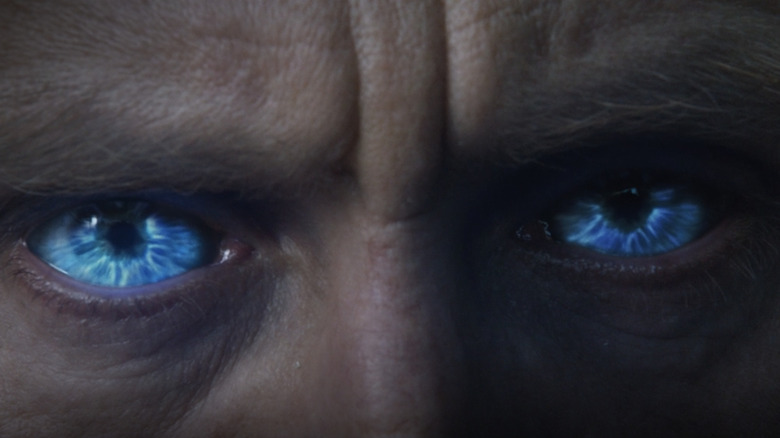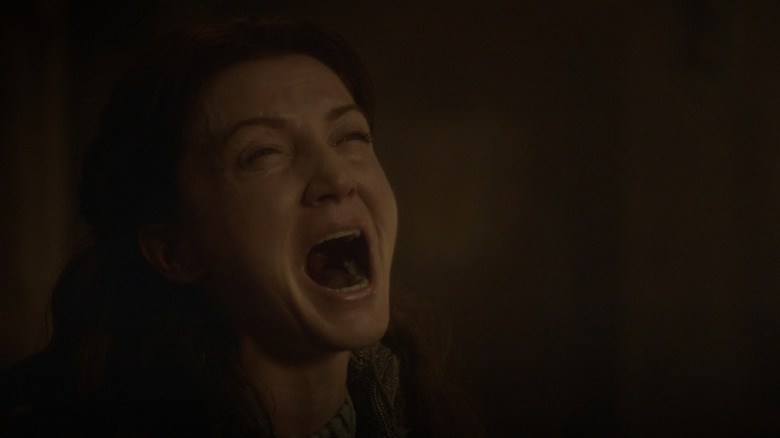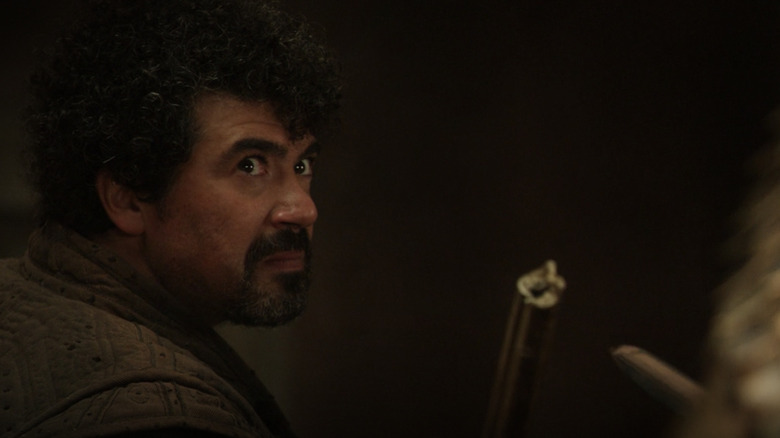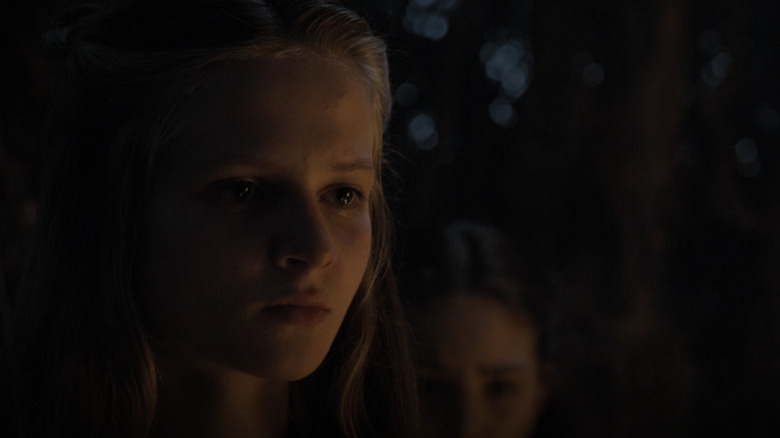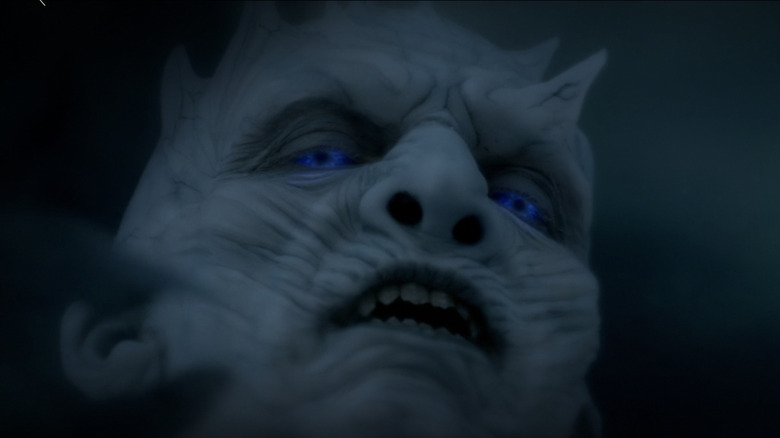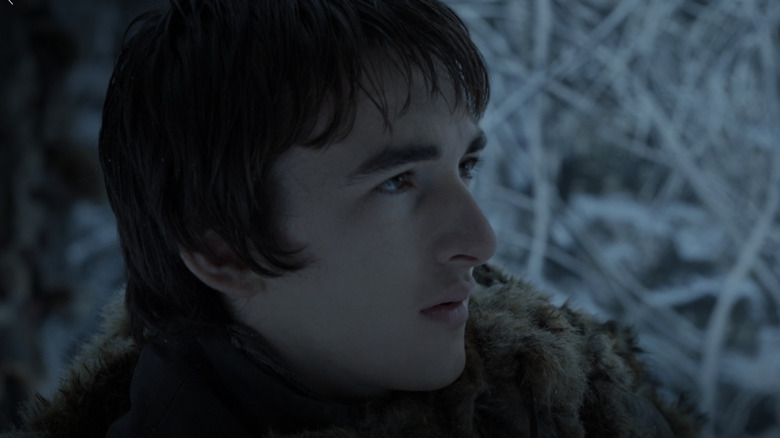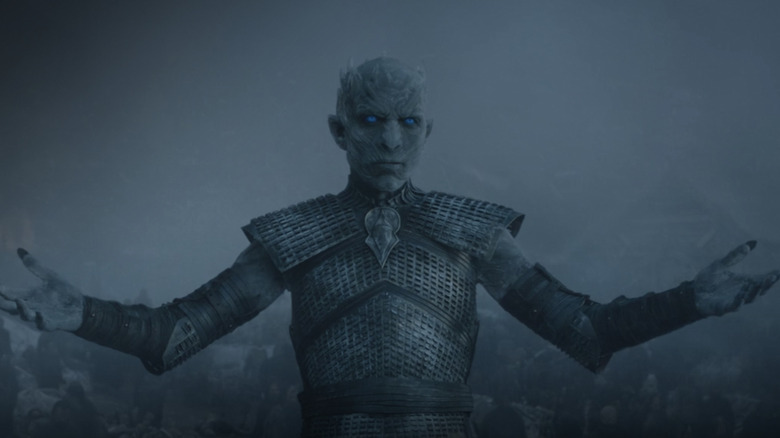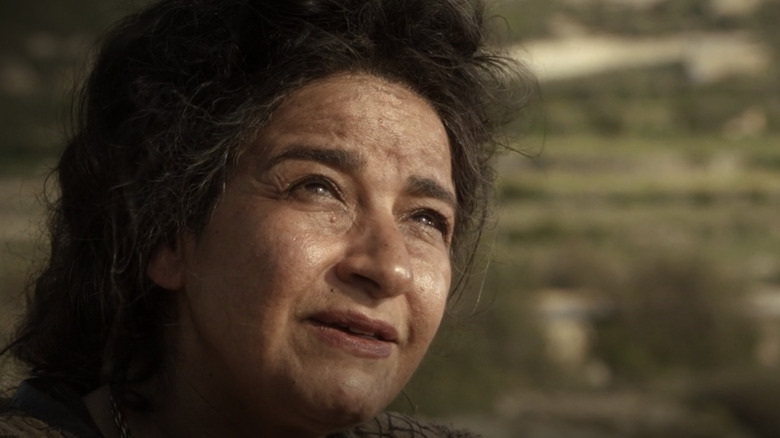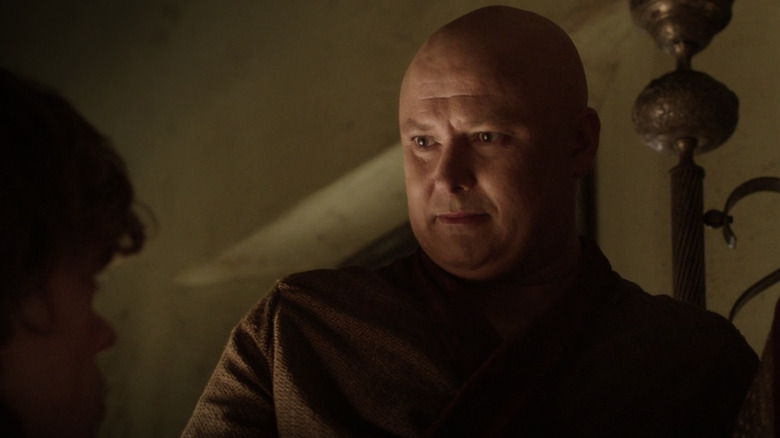The Wildest Game Of Thrones Theories That Didn't Pan Out
HBO's "Game of Thrones" TV series will principally be remembered for two things: a disappointing ending, and a legion of fans who think they could have done it better. Because the world created by George R. R. Martin in his novels is so intricate, and the original text is so heavily dotted with clues to the series' various secrets (and because of the extraordinarily long wait between books), "A Song of Ice and Fire" fans are the undisputed masters of the insane theory, and as the TV adaptation went on, those feverish ideas about what might happen next made their way into "Game of Thrones." Throw in the fact that each successive season of the show was less faithful to its source material than the one before (and eventually outpaced the still-uncompleted book series), keeping readers guessing as to what they would actually see, and you had an even thicker recipe for speculation – particularly in the final season, whose lackluster quality had fans guessing about what could be done to salvage it right up to the end.
There was nothing to be done, of course. Most of the theories (with the exception of the most popular one: Jon Snow was a Targaryen and the heir to the Iron Throne) didn't end up being true. But that doesn't mean it isn't fun to go back now and look at some of the crazy straws fans grasped at desperately during that final stretch of the show. These are the wildest "Game of Thrones" theories that didn't pan out, even if many still wish they had.
Catelyn Stark would come back from the dead
Most fan theories in the final days of the "Game of Thrones" series were entirely speculative — you could build a body of evidence to support an argument for them, but there was rarely anything resembling actual proof.
The one exception was the theory — and hope — that Catelyn Stark would be brought back from the dead, an event that fans of the books had spent years waiting to see. Following her death at the Red Wedding in Season 3, it was simply assumed that one of the ensuing seasons would close on the image of the Stark matriarch opening her undead eyes; this was for good reason: it happened in the books.
The third installment of Martin's series, "A Storm of Swords," ends with the reveal that Catelyn has been brought back to life by the Brotherhood Without Banners — whose leader, Beric Dondarrion, had been similarly resurrected. Once a warm, compassionate woman, Catelyn is now an embittered revenant, going by the name Lady Stoneheart and desiring nothing but bloody vengeance against both the Lannisters and the traitorous House Frey. With Beric having finally succumbed to death, Stoneheart has assumed leadership over the Brotherhood, which has become a twisted mockery of what it once was. It's a pretty major occurrence that, fans figured, could never just be left out.
Ultimately, the "Game of Thrones" show omitted the entire thing. After all those seasons of expectant waiting, Catelyn never came back. Instead, Beric somehow lasted all the way to Season 8, and the Freys were eventually massacred by Catelyn's daughter, Arya.
Syrio Forel was really Jaqen H'ghar in disguise
One of the most popular theories in the book fandom involved Syrio Forel, the Braavosi swordsman who (in both the books and the show) served as Arya Stark's "dancing master." Last seen facing off against a knight of the Kingsguard, it was a fight Syrio couldn't win, so he sacrificed himself so that Arya could escape.
Naturally, Arya assumed he was dead, and since we never actually heard otherwise, many fans did as well. But later, Arya met Jaqen H'ghar, an assassin who had been pulled out of the Black Cells in King's Landing, later demonstrating the ability to change his appearance, seemingly by magic.
This theory holds that Syrio and Jaqen are the same person — that Syrio was defeated, but taken to the Black Cells rather than being killed, where he changed into the man Arya knows as Jaqen. This would explain Jaqen's interest in Arya, and why he might be invested in the idea of her completing her training.
If readers were hoping the "Game of Thrones" TV show would confirm the theory, they were out of luck. In the series, Jaqen appeared again as Arya's instructor in the House of Black and White (a role filled in the books by the mysterious Kindly Man), and was never revealed to have been Syrio in disguise. It was a bit deflating for proponents of the theory, as it would have been a fairly easy reveal for the show to include, but maybe they just couldn't get actor Miltos Yerolemou (who played Syrio on the show) back to film it.
Cersei Lannister would be killed by Jaime (or Arya pretending to be Jaime)
Season 5 of "Game of Thrones" opened with a flashback: a young Cersei Lannister, having her fortune told by a sinister old woman named Maggy.
The witch informed Cersei that she would become queen (though she'll be deposed), and have three children (all of whom would die). Readers waited expectantly for the final part of the prophecy ... but it never came. In the books, Maggy also told young Cersei that she would be killed by "the valonqar," a term that means "little brother." This is part of the reason Cersei was so hateful toward her own little brother, Tyrion.
Despite the absence of the valonqar prophecy, many fans remained convinced that Cersei would be murdered at the end of the TV series — though, not by Tyrion. Popular wisdom had it that the valonqar actually referred to Jaime, who, despite being Cersei's twin, technically came out of the womb second. Then there was the show-specific "green eyes" theory, which was derived from Melisandre's prophecy that Arya Stark would kill people with green, brown, and blue eyes. After dispatching the brown-eyed Walder Frey and the blue-eyed Night King, it seemed plausible that the green-eyed Cersei was next — and hey, maybe Arya would do it while disguised as Cersei's little brother.
No such thing actually happened, of course. Cersei and Jaime were crushed to death by falling rocks, in what remains one of the series finale's most controversial choices.
Jon Snow (or maybe Daenerys Targaryen) was the Prince Who Was Promised
The "Game of Thrones" show never had much use for prophecy. It has always been a staple of Martin's series – interpreting the books' various visions of the future is a favorite activity in the fandom — and at this point, enough of them have come true that prophesized events feel like a real thing in the world of Westeros. But since the show rarely included them, and seemingly felt no obligation to fulfill them when it did, things like the so-called "Prince Who Was Promised" (a prophesied hero destined to wield a magic sword and fight back against the White Walkers) lost their power.
The primary purveyor of this particular legend was Melisandre, who proclaimed in Season 2 that Stannis Baratheon would become Prince. After Stannis' death, Melisandre switched her pick to the resurrected Jon Snow, though Season 7 still went out of its way to suggest that the Prince — which could also be a Princess — actually turned out to be Daenerys.
Hilariously, not only is the true identity of the Prince Who Was Promised never properly revealed, the entire concept was unceremoniously dropped in Season 8. Granted, the idea of it being Daenerys became difficult to imagine by the show's end, unless the promised hero's destiny was to get stabbed. It really did seem like it was going to be Jon, though — and who knows? Maybe it was.
Jon Snow would kill the Night King
If there was one way Jon could have proven he was the hero that the prophecy foretold, it would have been to kill the Night King, thus ending the threat of the White Walkers once and for all. Even without factoring in the whole "Prince Who Was Promised" thing, most people expected Jon to be the one who would finally put the leader of the ice zombies to rest. It just made sense: The Night King had been Jon's primary nemesis since the end of Season 5, when they stared one another down in the acclaimed episode "Hardhomme." The White Walkers, the Long Night, the Night's Watch, the terror coming south from beyond the Wall — these seemed to represent the primary aim of Jon's plot threads. Killing the Night King would have been the character's logical conclusion.
It was so logical, in fact, that the showrunners decided not to write it. Snow actor Kit Harrington, for his part, told Maisie Williams that he had been informed during Season 3 that he was going to do it.
"We didn't want it to be Jon because he's always saving the day," David Benioff explained in 2020, discussing the reversal. So instead, it became Arya who leapt out of the darkness and took down the Night King with a Valyrian steel dagger. The choice had no narrative or thematic resonance whatsoever, and seemingly let Jon with nothing to do during the battle but scream uselessly at a dragon — but hey, at least it wasn't obvious.
Bran was the Night King
Speaking of the Night King, there was another popular theory regarding everyone's favorite merciless ice villain heading into the final season of "Thrones." In addition to Jon, Bran was the other central protagonist with key connections to the Night King; both transformed by the Children of the Forest, Bran had even used his greensight ability to witness the Night King's creation. The Night King was known to hold a particular hatred for Bran, which Bran used to draw him to Winterfell's weirwood tree (where Arya was waiting) during their final battle. Many fans, however, believed that their connection ran even deeper — that the Night King was actually a time-displaced version of Bran himself.
This theory pointed out that Bran's greensight, combined with his ability to warg (possessing the bodies of animals and even people), would allow him to warg into somebody in the distant past. He'd also been warned on numerous occasions of the dangers of being stuck in someone else's body. The idea was that Bran, in an effort to stop the White Walkers by stopping the Night King from being made, would go back in time, warg into him, and become trapped. He would then live out the rest of his years, becoming increasingly bitter and waging war against all living things, until eventually meeting his younger self face-to-face in the godswood of Winterfell.
What exactly might have occurred then is up for debate — but it doesn't really matter, because it never happened.
The White Walkers would come back in the final episode (and possibly win)
Everyone had their own reaction to the "The Long Night," the third episode of the final season of "Game of Thrones," but the reaction most fans had was probably something along the lines of "...that's it?"
The White Walkers, after all, were the presumptive big bads of the entire series, the one enemy that more important than the political squabbles of the nobility. The Long Night was anticipated as the war to end all wars, humanity's last stand against the forces of cold and darkness. So when it ended halfway through the season, with the Night King and his forces melting away and almost every major character still alive, fans were confused.
Some believed that the White Walkers weren't gone for good; the show would most certainly end with Jon Snow discovering evidence that they were somehow still around. Martin, for his part, has described the planned ending of his books as "bittersweet," and that ending would have fit the bill. Others, however, became convinced the White Walkers would return in the last episode of the season — even taking the idea of a bittersweet ending to its logical extreme by positing that the Night King would win the war and kill most of the protagonists. This theory was seemingly reinforced by David Benioff when he refused to answer a question from Jimmy Kimmel about whether or not the White Walkers were really gone. As it turned out, the surprise ending to this storyline was that there was no surprise.
All magic in Westeros would be destroyed
One last theory about the destruction of the Night King would have entirely reshaped the world of "Game of Thrones" as we know it. It's a bit light on detail, but the idea was that in order to destroy the Night King, magic in general would have to be destroyed.
That's right — Dragons, direwolves, giants, the Children of the Forest, the Wall, Bran and his status as the Three-Eyed Raven — all of it would just be eradicated. Nobody advancing the theory was quite sure how this would happen, but in the end, Westeros would be completely free of magic (including any that might re-animate ice zombies). As it turned out, proponents of this theory had a lot going their way by the time Season 8 came around: the Wall had been breached, the Children of the Forest and the giants were gone, most of the direwolves were dead, and Dany had already lost a dragon.
The theory likely came from book readers looking for a subplot from the novels that never appeared in the show. While there's certainly something happening in the books regarding magic, however, you could make the easier argument that it was returning to this world rather than leaving it. There also appeared to be a plot among the Maesters of the Citadel to keep magic out of the world for good, though the details have never been revealed. Regardless, Bran himself is ruling Westeros by the end of the "Game of Thrones" TV series, so magic was still very much around.
Tyrion was a Targaryen (somewhat sane version)
The single most popular theory related to either the books or the show has become so widely accepted that its name has become ubiquitous among fans: R + L = J.
This theory posits that Jon Snow was secretly a Targaryen, the son of Rhaegar Targaryen and Lyanna Stark. Even before the "Game of Thrones" TV series confirmed the theory, book readers were certain of it, and had already turned their attention toward who else might be a secret Targaryen. After all, one the prophecies Daenerys learned in the books was that "the dragon must have three heads," implying that there were two additional Targaryens (and potential dragonriders), not just one. The strongest candidate for that role always seemed to be Tyrion Lannister.
There's actually more evidence to support this than you might think, particularly in the books, where we learned early about Tyrion's fascination with dragons. The books also revealed that Aerys Targaryen (Daenerys' father) had a thing for Tywin Lannister's wife. Considering Tywin's constant refusal to acknowledge his dwarf son as an heir — or indeed, treat him like a son at all — the case for the Mad King as Tyrion's real father feels somewhat plausible.
"The dragon must have three heads" never made it into the TV show, but fans still held out hope that they'd get to see Tyrion ride one of Dany's dragons by the end. In this, as in so many things related to the final season of "Game of Thrones," they would be disappointed.
Tyrion was a Targaryen (completely insane version)
There's a second theory about how Tyrion might end up having Targaryen blood — but you'll want to strap in for this one, because it gets pretty wild. According to this theory, Tyrion doesn't actually have any Lannister blood whatsoever, because his real parents were — wait for it — Daenerys Targaryen and Khal Drogo.
Yeah. So, you remember how Dany got pregnant with Drogo's child, who was supposed to be "the Stallion Who Mounts The World," but who was actually stillborn and monstrously deformed? This "time traveling fetus" theory holds that Mirri Maz Duur, the witch who delivered the baby, actually sent him back in time and into the womb of Joanna Lannister. Her true child was then sent forward into Dany's womb, but didn't survive the process. According to Mirri Maz Duur in the "GOT" novels, the baby "had been dead for years." In both the books and the show, she told Dany that Drogo would come back to her "when the sun rises in the west and sets in the east," which proponents of this theory claim was an indication of a reversal in time. So, when Tyrion crossed the sea and stood before Daenerys, in a way, Drogo had returned to her in the form of their son.
There's more to it than that, but it is extremely unlikely that this theory will prove true in the "Game of Thrones" books, and it obviously didn't happen on the show. Honestly, that's probably for the best, because nobody needs to see Tyrion lusting after his own mom.
Varys was a merman
You may have thought this utter madness was exhausted — but there's one more fan theory to discuss, and this one is a doozy.
In both the books and TV series, some believe that Varys (played by Conleth Hill) was actually a creature of the watery depths. In the books, there are mythical sea creatures called merlings, which are the same thing as mermaids and mermen from our real world mythology. The theory holds that Varys — and his friend across the sea, Illyrio Mopatis — are secretly merlings, manipulating the humans on the surface to benefit their own people. Actually, there are any number of people who could be merlings, according to this theory, but Varys and Illyrio are the main ones. Supposedly, their goal is to bring back the dragons, get them to the North and melt the Wall, raising the seas and instituting a new world ruled by the merlings. Now that's a master plan.
As you might expect, the evidence for this theory is scant, but its supporters must have been thrilled in Season 2, when Tyrion threatened to throw Varys into the sea. "You might be disappointed in the results," Varys replied. "The storms come and go, the big fish eat the little fish, and I keep on paddling." They must have been equally devastated when he was burned to death, seemingly putting the "Varys is a merman" theory to rest forever.
